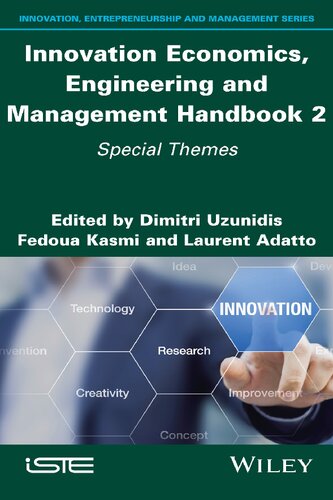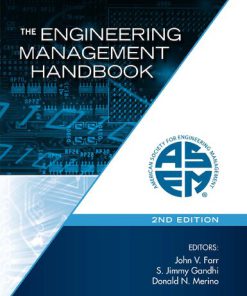Innovation Economics Engineering and Management Handbook 2 Special Themes 1st Edition by Dimitri Uzunidis, Fedoua Kasmi, Laurent Adatto ISBN 9781786307019 1786307014
$50.00 Original price was: $50.00.$25.00Current price is: $25.00.
Innovation Economics Engineering and Management Handbook 2 Special Themes 1st Edition by Dimitri Uzunidis, Fedoua Kasmi, Laurent Adatto – Ebook PDF Instant Download/Delivery: 9781786307019 ,1786307014
Full download Innovation Economics Engineering and Management Handbook 2 Special Themes 1st Edition after payment

Product details:
ISBN 10: 1786307014
ISBN 13: 9781786307019
Author: Dimitri Uzunidis, Fedoua Kasmi, Laurent Adatto
Innovation Economics Engineering and Management Handbook 2 Special Themes 1st Edition Table of contents:
1 Meaning – The Meaning of Innovation: Theoretical and Practical Perspectives
1.1. Introduction
1.2. Conceptions of the meaning of innovation over time
1.3. When innovation, like the phoenix, rises from the ashes
1.4. In search of lost meaning
1.5. The PSI approach: a philosophy of, and for, action
1.6. By way of conclusion
1.7. References
2 Engineering – Innovation Engineering: A Holistic and Operational Approach to the Innovation Process
2.1. Introduction
2.2. Innovation engineering: a field of research that has struggled to structure itself in France
2.3. Practical guide to innovation engineering
2.4. Conclusion
2.5. Acknowledgments
2.6. References
3 Absorption – Technological Absorptive Capacity and Innovation: The Primacy of Knowledge
3.1. Introduction
3.2. Technological absorptive capacity: a cognitive process
3.3. The multidimensional nature of absorption capacity and innovation
3.4. Measuring absorptive capacity
3.5. Conclusion
3.6. References
4 Big Data – Artificial Intelligence and Innovation: The Big Data Issue
4.1. Introduction
4.2. Humans and data: diversity and consensus
4.3. Big Data: an interdisciplinary approach to technology and its uses
4.4. A wide range of applications: promises and fears
4.5. Conclusion
4.6. References
5 Blockchain – Blockchain and Co-creation within Management Methods
5.1. Introduction
5.2. The interest of Blockchain in the field of immaterial exchanges
5.3. The limits of the co-creation process
5.4. Blockchain in mobilizing and organizing co-creation processes
5.5. The promises of Blockchain
5.6. Conclusion
5.7. References
6 Bricolage – From Improvisation to Innovation: The Key Role of “Bricolage”
6.1. Introduction
6.2. Bricolage: new concept, old practice
6.3. Current application of the bricolage concept
6.4. Bricolage and improvisation
6.5. Bricolage and frugal innovation
6.6. Conclusion
6.7. References
7 Circularity – The Circular Economy as an Innovative Process
7.1. Introduction
7.2. The circular economy: a transformative concept
7.3. The circular economy as a source of innovation
7.4. Conclusion
7.5. References
8 Co-creation – Co-creation and Innovation: Strategic Issues for the Company
8.1. Introduction
8.2. Co-creation: a strategic challenge for companies
8.3. Co-creation, DIY and DIWO
8.4. Co-creation, creativity and innovation
8.5. Co-creation and intellectual property rights
8.6. Co-creation and eco-design
8.7. Conclusion
8.8. References
9 Community – Innovative Communities of Practice: What are the Conditions for Implementation and Innovation?
9.1. Introduction: communities of practice and innovation
9.2. Communities of practices, a definition: group cohesion, complicity and dynamism
9.3. Work teams and virtual communities
9.4. Organizational learning
9.5. Animation role
9.6. Conclusion
9.7. References
10 Craftsman – The Innovative Craftsman: A Historically Permanent Socio-economic Function
10.1. Introduction
10.2. The craftsman, an ignored innovator
10.3. The innovative craftsman of the 21st century
10.4. Conclusion
10.5. References
11 Defense – Military Innovation: Networks and Dual-use Technological Development
11.1. Introduction
11.2. Military innovation: main attributes
11.3. Conclusion
11.4. References
12 Design Thinking – Design Thinking and Strategic Management of Innovation
12.1. Introduction
12.2. The origins of design thinking
12.3. Design thinking in innovation management
12.4. Conclusion
12.5. References
13 Digital – Digital Entrepreneurship as Innovative Entrepreneurship
13.1. Introduction
13.2. Definition and characteristics of digital entrepreneurship
13.3. Digital entrepreneurship in the field of innovation studies
13.4. Conclusion
13.5. References
14 Entrepreneurship – Social Innovative Entrepreneurship: An Integrated Multi-level Model
14.1. Introduction
14.2. State-of-the-art: contemporary issues, approaches and levels of analysis
14.3. Integrated multi-level model of innovative social entrepreneurship
14.4. Conclusion
14.5. References
15 Fintech – Technology in Finance: Strategic Risks and Challenges
15.1. Introduction
15.2. Evolution of technology in finance
15.3. Risks of fintech
15.4. Concluding remarks
15.5. References
16 Gerontech – Geront’innovations and the Silver Economy
16.1. Introduction
16.2. The Silver Economy: a new area for innovation
16.3. “Gerontechnologies”: the technological dimension of innovations in the Silver Economy
16.4. Towards “geront’innovation”
16.5. Conclusion
16.6. References
17 Greentech – Contributions and Limitations to the Environmental Transition
17.1. Introduction
17.2. Green technologies, the first technological response to the environmental crisis
17.3. From green technologies to a sustainable technological and socio-economic system
17.4. References
18 Hacker – Hackerspace as a Space for Creative Exploration
18.1. Introduction
18.2. The rise of hacker culture
18.3. Cybercrime or creative exploration?
18.4. Conclusion
18.5. References
19 Health – Telemedicine: Decentralized Medical Innovation
19.1. Introduction
19.2. Information technology at the service of medical care
19.3. High-performance medical devices
19.4. Conclusion
19.5. References
20 Intellectual Corpus – Inventive Intellectual Corpus: Knowledge-based innovation
20.1. Introduction
20.2. Concept of knowledge-based innovation
20.3. Modeling knowledge creation
20.4. Activation of the chaotic inspiration model of knowledge evolution by emergence using the ICAROS® method
20.5. Conclusion
20.6. References
21 Imagination – Imagination, Science Fiction, Creativity and Innovation: An Integrated Process
21.1. Introduction
21.2. Tame the imagination in order to innovate
21.3. Imagination: from creativity to innovation
21.4. Conclusion
21.5. References
22 Marketing – Marketing of Innovation and University–Industry Collaboration
22.1. Introduction
22.2. Innovation marketing and inter-organizational collaboration
22.3. The cross-functionality of innovation marketing
22.4. Conclusion
22.5. References
23 Milieu – Innovative Milieu: The Strength of Proximity Ties
23.1. Introduction
23.2. Definition and characteristics of an innovative milieu
23.3. Proximity and territorialized innovation networks
23.4. Conclusion
23.5. References
24 Nanotech – Nanotechnologies: The Future of Innovations
24.1. Introduction
24.2. Nanotechnology applications
24.3. RFID chips
24.4. Global potential risks
24.5. Conclusion and outlook
24.6. References
24.7. Webography
25 Novelty – Novelty and Innovation: The Nodal Place of Creativity
25.1. Introduction
25.2. Innovation and novelty
25.3. Creativity as a prerequisite for innovation
25.4. Conclusion
25.5. References
26 Open – Open Source and Open Data: Filiation, Analogies and Common Dynamics
26.1. Introduction
26.2. Open source and open data: guiding concepts
26.3. Open source: process innovation and legal innovation via copyleft
26.4. Open data: dynamics of open innovation 2.0 in line with open source
26.5. Conclusion
26.6. References
27 Personality – The Deviant Personality of the Innovative Actor
27.1. Introduction
27.2. The actor, the system and the question of the complementarity of roles
27.3. The deviant personality of the innovator
27.4. Conclusion
27.5. References
28 Real Estate – Business Real Estate and Innovation: A New Profession for New Spaces
28.1. Introduction
28.2. The prevalence of the financial referent, reasoning and industrialist practices
28.3. Weakness of the human resources paradigm applied to real estate
28.4. Employees empowered by change management
28.5. Powerful, but inconsistent with regard to use, real estate marketing
28.6. The real estate market versus the innovative company
28.7. Conclusion
28.8. References
29 Skills – Innovation and Entrepreneurial Skills
29.1. Introduction
29.2. Innovation skills
29.3. Entrepreneurial competencies
29.4. Ideas and opportunities
29.5. Resources
29.6. Into action
29.7. References
30 Small Business – Small Business and Innovation: Specificities and Institutional Context
30.1. Introduction
30.2. The relation between small business and innovation
30.3. The specificity of small business innovation
30.4. Government support for small business innovation
30.5. Conclusion
30.6. References
31 Spin-off – Research Spin-off: How the University Fosters Innovative Entrepreneurship
31.1. Introduction
31.2. An overview of the development of research spin-offs
31.3. Main perspectives and taxonomies of research spin-offs
31.4. Fragility and future avenues for improvement
31.5. Conclusion
31.6. References
32 Start-up – Start-ups, Venture Capital (SVC) and the Financial Cycle of the SVC System
32.1. Introduction
32.2. Start-ups
32.3. Venture capital
32.4. The SVC system cycle
32.5. Conclusion
32.6. References
33 Territory – Territorial Dynamics and Innovative Services
33.1. Introduction
33.2. Innovation in services: what are we talking about?
33.3. Geography of innovation in knowledge-intensive business services and territorial impact
33.4. Public innovation policy: historical actions and future prospects
33.5. Conclusion
33.6. References
34 Well-being – Subjective Well-being and Innovation
34.1. Introduction
34.2. Creative destruction impacts subjective well-being
34.3. A questionable relationship
34.4. Innovation-care: theoretical approach and applications
34.5. Conclusion
34.6. References
List of Authors
Index
People also search for Innovation Economics Engineering and Management Handbook 2 Special Themes 1st Edition:
johns hopkins engineering innovation acceptance rate
int. j. engineering management and economics
k&n engineering management
principal innovation engineer
management and economics of innovation
Tags: Dimitri Uzunidis, Fedoua Kasmi, Laurent Adatto, Innovation Economics, Engineering, Management
You may also like…
Business & Economics
Handbook of Media Management and Economics 2nd Edition by Alan Albarran 9781351747523 1351747525
Uncategorized
Business & Economics - Markets
Port Economics, Management and Policy 1st Edition Theo Notteboom
Business & Economics - Markets
Business & Economics - Management & Leadership
Principles of Economics and Management for Manufacturing Engineering 1st Edition D.R. Kiran
Computers - Databases
Business & Economics - Project Management
Uncategorized
Politics & Philosophy - Politics











